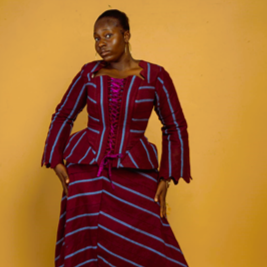In an era where contemporary fashion is often defined by fleeting trends and minimalist uniformity, Kehinde Faoziyat Abiona stands apart as a designer deeply rooted in cultural reverence and expressive storytelling. Her latest creation, TIWANTIWA, released under her brand Fabique Beauty, is a resounding testament to her unwavering commitment to Afrocentric design and her deft ability to weave cultural symbolism into wearable art.
At first glance, TIWANTIWA captivates with its bold use of Kente-inspired print, a fabric that carries generations of West African history and tradition. However, what distinguishes this piece is not merely the richness of the textile, but the precision with which Kehinde employs it. The geometric symmetry, the vibrant interplay of warm tones, and the rhythmic patterns reflect a designer who possesses not only an artistic eye but also a scholarly appreciation of African heritage. There is no randomness in her choice; every motif and hue resonates with cultural depth and meaning.

The silhouette of the garment further showcases Kehinde’s creative sophistication. The fitted bodice and floor-length cut provide a canvas of elegance and modesty, while the layered overfacing on the frontal half-length introduces a compelling dimension of sculptural form. This feature transitions into a flared cape cascading gracefully from the left side; an intentional asymmetry that speaks volumes. The cape, seemingly fluid and unfettered, is a symbol of liberation and feminine strength. It celebrates the dynamism and unyielding spirit of African women who, throughout history, have embodied resilience, grace, and fortitude. The gown also offers a graceful flow in movement.
From a technical standpoint, the garment is a study in precision. The tailoring is immaculate, contouring the form with dignified restraint. The designer’s ability to balance ornate fabric with restrained construction reflects her maturity in design philosophy. The styling, with its minimal clean tailoring ensures that the focus remains on the garment’s narrative, allowing its cultural voice to resonate undistracted.
However, the design appears too simple to satisfy pure elegance and class. Although for a minimalist, it may appear as a good pick. Moreso, the slit opening at the back of the gown could have been extended beyond the length it appears on the dress to allow for comfortability, graceful and majestic movement characteristic of African women.
Kehinde Faoziyat Abiona’s TIWANTIWA is not merely a garment; it is an ode. It is a bold affirmation of African identity, a reflection of feminine power, a fine demonstration of the harmony between tradition and innovation. In this piandece, Kehinde affirms her place not only as a fashion designer but as a custodian of cultural memory and a visionary artist.




